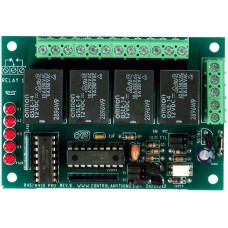RS-232 4-Channel Relay Controller Board with General Purpose SPDT Relays
Pro Series Relay Control
Control All or Individual Relays with Two-Way Communication
Quick Start Kit Available for Easy RS232 Connection
Highly Reliable Relay Board For Demanding Applications
RS-232 Serial Relay Controller
Our RS-232 Relay Boards are fully E3C complaint, allowing up to 256 NCD devices to share a single RS-232 serial port. Mix and match up to 256 devices in any combination. Speak to each device individually or all devices at once. To control the this Relay Controller, simply connect a data and ground wire between the Relay Controller and computer or microcontroller. Provide +12 Volts DC to the board, and send ASCII character codes to control the relays. Even a no-frills design deserves a high-quality driver stage, and that’s exactly what we put on our Serial Relay Controllers. Fast-reacting flyback diodes help shunt dangerous voltages away from the driver circuit. Features include no-click startup, LED status lights, and E3C compliance. Relays can be controlled at 9600 baud and the board is compatible with ANY computer or microcontroller capable of delivering RS-232 data. Connect this board to the USB port of your computer using a USB to Serial adapter. The USB to Serial Adapter is to be used with the Quick Start Kit and is available at checkout.
NCD Component Library
Fully functioning programs for the Pro Series Controllers are included with the NCD Component Library. With the NCD Component Library we’ve “started” the programming for you. We say started because these are fully functioning samples but we’ve also included the source code so you can customize them to your exact needs. The NCD Component Library is a plug-in for the Visual Studio 2005/2008 that greatly simplifies the communications to the NCD product line. The samples can be run in Visual Studio and fully customized to your needs. Four different Pro Series samples are available including Relay Control, Read Status and Timing Features , to view screen shots of each sample visit our NCD Component Library Page. Start by downloading the FREE NCD Component Library and you will be communicating with any NCD device faster that ever!
The above sample demonstrates control and status read of up to 8 Relays. Compatible with all Pro (NOT ProXR) Series Relay Controllers, Including 4 and 8-Channel SPDT and DPDT Versions.
The above screen shot shows one of the four available fully functioning Pro Series samples that are available with the NCD Component Library. View all the examples on our NCD Component Library Page.

RS-232 Serial
NCD RS-232 Serial Communication modules make it easy to integrate the worlds most prolific communication standard. Easily interface to desktop PCs and laptops for easy control via standard serial commands. Most NCD devices typically default to 115.2K Baud; however, older low-cost devices implement 9600 baud data rate as the predominate standard.
10-Amp SPDT Relay Option
This controller is available with a 10-Amp relay option, allowing control of higher-power loads up to an absolute maximum of 240VAC at 10 Amps. Ideal for general purpose switching applications, this relays is focused on power-switching, and should never be used for low-power signals due to a higher On resistance of up to 150 Ohms when relay contacts are new (contact resistance drops to less than 1 Ohm after break-in period). The 10-Amp relay is of the SPDT variety, which provides Common (C), Normally Open (NO), and Normally Closed (NC) connections. Common is connected to NC when the relay is off. Common disconnects from NC and connects to NO when the relay is activated. All connections are made via screw terminals, capable of accepting up to 12 AWG wire.
5-Amp SPDT Relay Option
This controller is available with a 5-Amp relay option, allowing control of higher-power loads up to an absolute maximum of 240VAC at 5 Amps. Ideal for general purpose switching applications, this relays is focused on power-switching, and should never be used for low-power signals due to a higher On resistance of up to 150 Ohms when relay contacts are new (contact resistance drops to less than 1 Ohm after break-in period). The 5-Amp relay is of the SPDT variety, which provides Common (C), Normally Open (NO), and Normally Closed (NC) connections. Common is connected to NC when the relay is off. Common disconnects from NC and connects to NO when the relay is activated. All connections are made via screw terminals, capable of accepting up to 12 AWG wire.
Features
- 1200/2400/9600/19.2K Baud Operation
- Power LED, Relay Status LEDs
- Control Status of All or Individual Relays
- Read Status of All or Individual Relays
- Two-Way Communication Capabilities
- Integrated Timer Functions
- E3C Compliance
- Programmable Relay Memory
- Optoisolated RS-232 Inputs
- 2 RS-232 Input Levels
- +12 Volt Operation, 2/3-Wire RS-232
- Overkill Transistor Drivers
- No-Click Power-up
- See Manual for Outline Dimensions
Enter the code in the box below:


